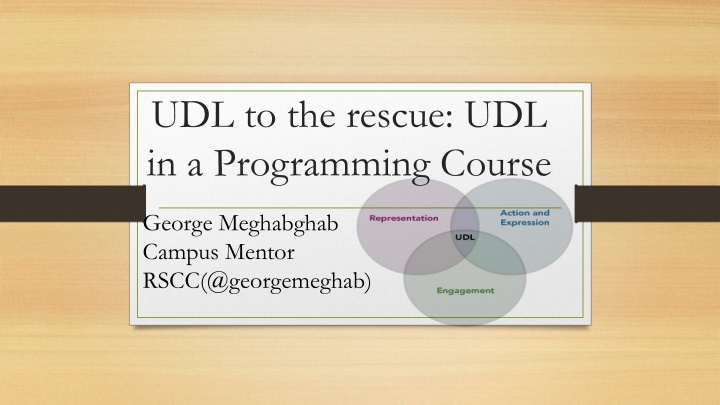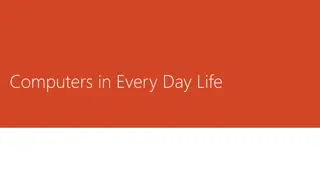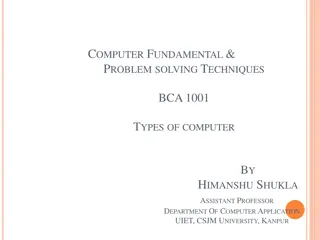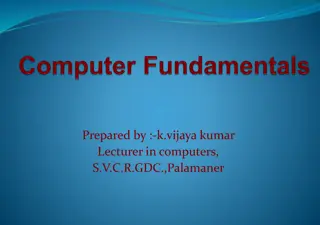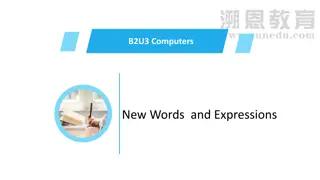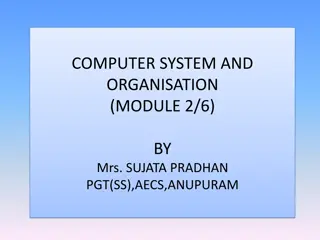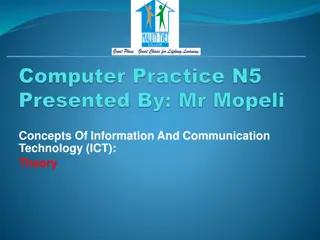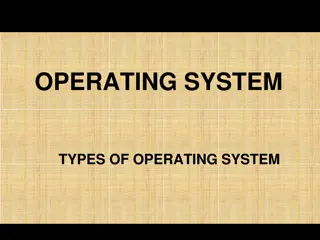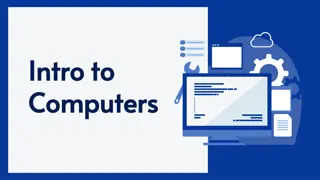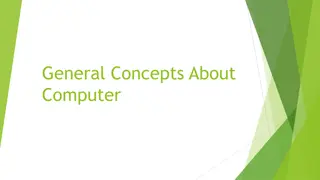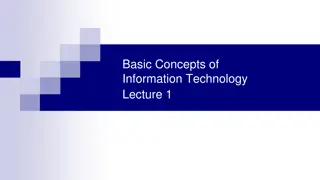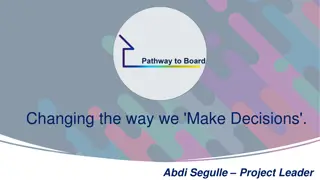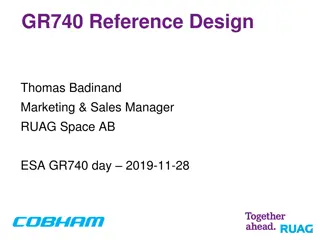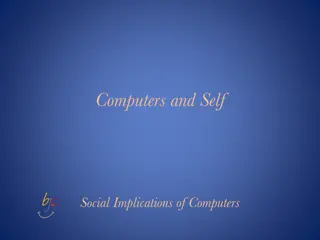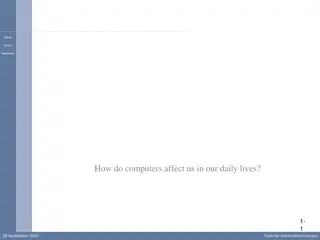Assessing the Use of Single Board Computers in Teaching
This study evaluates the effectiveness of Single Board Computers (SBCs) as a teaching tool for parallel computing. It includes pre- and post-survey questions assessing confidence levels in various parallel programming concepts and the motivation to learn more about parallel computing. The findings provide insights into the impact of using inexpensive multicore computers like the Raspberry Pi in enhancing student learning outcomes in the field of parallel computing.
Download Presentation

Please find below an Image/Link to download the presentation.
The content on the website is provided AS IS for your information and personal use only. It may not be sold, licensed, or shared on other websites without obtaining consent from the author.If you encounter any issues during the download, it is possible that the publisher has removed the file from their server.
You are allowed to download the files provided on this website for personal or commercial use, subject to the condition that they are used lawfully. All files are the property of their respective owners.
The content on the website is provided AS IS for your information and personal use only. It may not be sold, licensed, or shared on other websites without obtaining consent from the author.
E N D
Presentation Transcript
UDL to the rescue: UDL in a Programming Course George Meghabghab Campus Mentor RSCC(@georgemeghab)
UDL Framework: 3 Principles Multiple means of representation: What (Recognition Networks) Multiple means of action and expression: How (Strategic Networks) Multiple means of engagement: Why (Affective Networks)
UDL Framework: 9 guidelines WHAT(Recognition Networks) 1.Provide options for perception 2.Provide options for language, mathematical expressions, and symbols 3.Provide options for comprehension
UDL Framework: 9 guidelines HOW(Strategic Networks) 4. Provide options for physical action 5. Provide options for expression and communication 6. Provide options for executive functions
UDL Framework: 9 guidelines (cont) WHY(Affective Networks) 7. Provide options for recruiting interest 8. Provide options for sustaining effort and persistence 9. Provide options for self-regulation
Summary of UDL 3 Principles 9 Guidelines: Different combinations of 3 guidelines out of 9: 9C3=9*8*7/6=84 31 Checkpoints=Different combinations of 3 checkpoints out of 31: 31C3=31*30*29/6=4495
UDL Research in Programming UDL claims to be highly based on research as it stated by their own web site: (http://www.udlcenter.org/research/researchevidence): The UDL Guidelines are based on research from several very different fields and from many different researchers at many different universities and research organizations Lack of any serious research on the application of UDL in computer science in general and programming in particular. Lack of even practical application and observation of UDL in computer science related field.
Revel Platform as a Foundation of Engagement in Learning Programming Read a little Do a little High Impact Dynamic Content
Digital Immersive Learning Decrease Extraneous Cognitive Load Increase Active and Constructive Engagement Supply Immediate Feedback
Cognitive Load (CL)= Total amount of mental effort used in the working memory Intrinsic CL: Mental Effort Used in learning. Extraneous CL: Mental effort spent on distracting elements not relevant to the learning.
Decrease Extraneous CL Optimal Learning Space(OLS) Design Manageable pieces of consistent structure. Learner does not feel overwhelmed. Interface is highlighted and coded for key activities. Contiguous learning space for each segment leaners occupy.
Increase Active & Constructive Engagement Spacing content content that includes interactive content, spacing the interaction with active pauses benefits learners. interactivity improves between learning. subsets Instructional of
Increase Active and Constructive Engagement with Multiple Methods Media Interactives: Simulation Animation Drag-and-drop matching activities Interactive maps Videos
Supply Immediate Feedback Specific to the task at hand; Provides concrete information on learner; Connects each task to the next content. Throughout each unit, learners check their understanding at regular intervals before moving on using formative assessments.
Supply Immediate Feedback(cont) Actionable Feedback: Learners can learn from their mistakes and keep moving forward. Trackable Feedback: Detailed information on performance in terms of specific learning objectives enables experts to intervene when necessary to keep each individual learner on track.
1. Decrease Extraneous Cognitive Load helping to target focus students learn to be present 2. Increase Active and Constructive Engagement providing the wow factor more than memorization 3. Supply Immediate Feedback Happens in real time Creates evidence of learning for the student Proof of learning along the way
Assessment of Digital Immersion 1. Measurable impact on learner outcomes: Access Completion Competence Progression 2. Evidence-based design provides both learners and experts with activity results. 3. Data results drive improvement in product design.
Data Results on Programming I: Fall 2017 REVEL1: SUCCESS VS TIME FOR COMPLETION 600 500 400 300 200 100 0 0% 20% 40% 60% 80% 100% 120%
Data Results on Programming I: Fall 2017 REVEL2 : SUCCESS VS TIME FOR COMPLETION 1000 900 800 700 600 500 400 300 200 100 0 0% 20% 40% 60% 80% 100% 120%
Data Results on Programming I: Fall 2017 REVEL3 : SUCCESS VS TIME FOR COMPLETION 700 600 500 400 300 200 100 0 0% 20% 40% 60% 80% 100% 120%
Data Results on Programming I: Fall 2017 REVEL4 : SUCCESS VS TIME FOR COMPLETION 900 800 700 600 500 400 300 200 100 0 0% 20% 40% 60% 80% 100% 120%
Impact of Revel1 on Drobox1 and Test1: Programming I Impact of Revel1 on Drobox1 and Test1 120 120% 100 100 100 100 100 100 100 100 100 100 100 100 100 100 100 100% 100% 100% 100% 100% 100% 100% 100% 100% 100% 100% 100% 100% 100% 100% 92.86 92.86 92.86 92.86 92.86 92.86 90 85.71 85.71 85.71 85.71 78.57 78.57 83% 83% 83% 83% 80 80% 71.43 64.29 60 60% 50 50 40 40% 20 20% 0 0 0 0 0 0 0% 1 2 3 4 5 6 7 8 9 10 11 12 13 14 15 16 17 18 Dropbox1 Test1 Revel1
Impact of Revel2 on Drobox2 and Test2: Programming I Impact of Revel2 on Drobox2 and Test2 120% 100% 100% 100% 92.86% 100% 100% 100% 100% 100% 100% 100% 100% 100% 100% 100% 100% 92.86% 100% 100% 100% 100% 100% 100% 100% 100% 100% 100% 100% 100% 97% 97% 97% 90% 93% 85.71% 85.71% 85.71% 85.71% 78.57% 78.57% 78.57% 78.57% 83% 80% 71.43% 77% 64.29% 55% 60% 50% 35.71% 40% 20% 0% 0 0 0% 1 2 3 4 5 6 7 8 9 10 11 12 13 14 15 16 17 Drobox 2 Test2 Revel2
Impact of Revel3 on Drobox3 and Test3: Programming I Impact of Revel3 on Drobox3 and Test3 120 120% 100 100 100 100 100 100 100 100 100 100 100 100 100 100% 92.86 100% 100% 100% 100% 100% 100% 100% 100% 90 96% 96% 85.71 85.71 85.71 85.71 85.71 85.71 85.71 85 89% 89% 86% 78.57 78.57 82% 80 80% 71.43 70 75% 68% 64% 60 60% 50 50 50 50% 40 40 40% 28.57 20 20% 0 0 0 0 0 0 0% 1 2 3 4 5 6 7 8 9 10 11 12 13 14 15 16 17 18 Dropbox3 Test3 Revel3
Impact of Revel4 on Drobox4 and Test4: Programming I Impact of Revel4 on Drobox4 and Test4 120% 100% 100% 100% 92.86% 100% 100% 100% 100% 100% 100% 100% 92.86% 100% 100% 100% 100% 100% 100% 100% 92.86% 100% 100% 100% 100% 100% 92.86% 90% 100% 100% 100% 100% 100% 100% 100% 90% 95% 95% 95% 85.71% 85.71% 90% 78.57% 78.57% 85% 80% 80% 75% 64.29% 70% 60% 50% 50% 50% 40% 20% 0 0 0 0% 1 2 3 4 5 6 7 8 9 10 11 12 13 14 15 16 17 18 Dropbox4 Test4 Revel4
References Bashan, J. D., & Gardner, J. (2010). Measuring Universal Design for Learning. Special Education Technology Practice, 12(2), 15-19.Retrieved from Education Research Complete database Erlandson, R. F. (2002). Universal Design for Learning: Curriculum, technology, and accessibility. Retrieved from ERIC database (ED477004) Lodico, A. G., Spaulding, D. T., & Voegtle, K. H. (2010). Methods in educational research, from theory to practice. (2nd Edition). San Francisco: Jossey-Bass. Maryland State Department of, E. (2011). A route for every learner: Universal Design for Learning (UDL) as a framework for supporting learning and improving achievement for all learners in Maryland, prekindergarten through higher education. Maryland State Department of Education. Retrieved from ERIC database (ED519800) Pritchard, A. (2009). Ways of learning : Learning theories and learning styles in the classroom. Taylor & Francis Routledge. Retrieved from Ebook Collection Database Rose, D. H., & Meyer, A. (2011). A practical reader in universal design for learning. (5 ed.). Cambridge: Harvard Education Press
